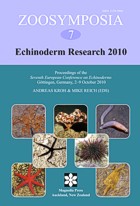Abstract
Tomographic imaging techniques such as micro-computed tomography (μCT) and magnetic resonance imaging (MRI) permit the gathering of digital anatomical data from whole animal specimens non-invasively. The resulting datasets can be used for direct observation of the two-dimensional tomographic image data as well as for manual and semi-automated three-dimensional modelling. Freshly fixed specimens as well as preserved museum material can be successfully analyzed using this approach, giving the zoomorphologist a powerful tool for large-scale comparative studies. In order to demonstrate the principle suitability of non-invasive imaging in echinoderm research, μCT scans of 199 and MRI scans of 92 sea urchin (Echinodermata: Echinoidea) species were acquired, resulting in a total of 203 analyzed echinoid species. The taxa selected represent 50 of the currently recognized 60 extant sea urchin families. The present article lists all species that have been analyzed so far and provides information about the scanning parameters employed for each dataset. Furthermore, the workflow established to generate three-dimensional models of sea urchins is outlined. Using a number of examples from μCT as well as MRI scans performed on echinoids, the potential of the systematic approach described here is highlighted. Finally, the suitability of non-invasive imaging techniques for the study of other echinoderm taxa is assessed based on multimodal datasets of representative species.

